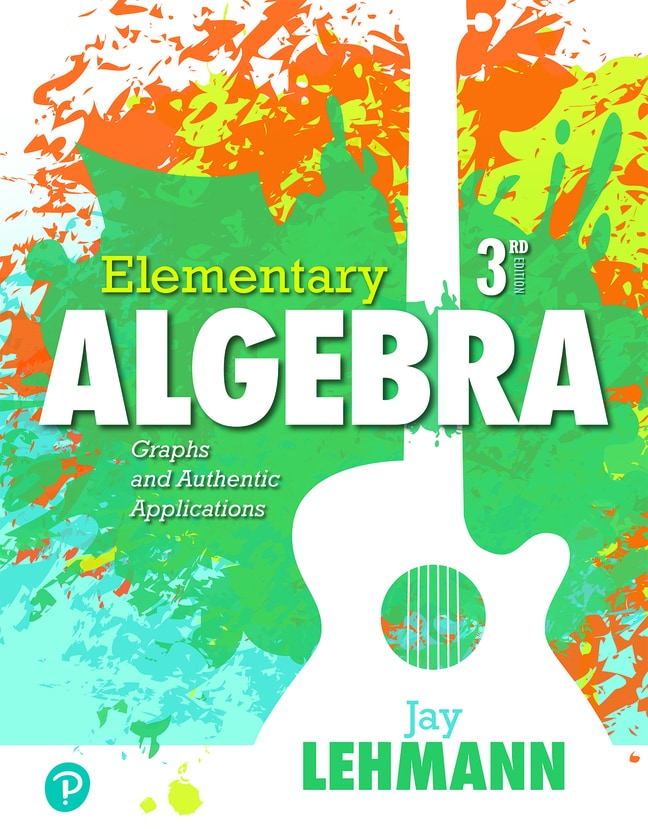
Elementary Algebra: Graphs and Authentic Applications, 3rd edition
- Jay Lehmann

- Watch and learn
Videos & animations bring concepts to life
- Find it fast
Quickly navigate your eTextbook with search
- Stay organized
Access all your eTextbooks in one place
- Easily continue access
Keep learning with auto-renew
Are you looking for a new sound in algebra? Seeking to answer the perennial question “But what is this good for?” Elementary Algebra models authentic data through curve-fitting to give new meaning to the math. It uses authentic, real-life data sets to find models and derive equations that fit the scenario. The curve-fitting approach teaches the mathematical concepts within the context of data, engaging you from the start and building conceptual understanding. The 3rd Edition updates data sets throughout and offers new Large Data Set exercises to get you comfortable with analyzing big data. New downloadable data sets support the appropriate use of technology when completing exercises and labs. Throughout, even more resources are provided for you to practice, review and explore concepts.
Published by Pearson (December 11th 2020) - Copyright © 2019
ISBN-13: 9780137399482
Subject: Developmental Math
Category: Beginning Algebra
- Introduction to Modeling
- 1.1 Variables and Constants
- 1.2 Scatterplots
- 1.3 Exact Linear Relationships
- 1.4 Approximate Linear Relationships
- Taking It to the Lab: Climate Change Lab • Volume Lab • Linear Graphing Lab: Topic of Your Choice
- Operations and Expressions
- 2.1 Expressions
- 2.2 Operations with Fractions
- 2.3 Absolute Value and Adding Real Numbers
- 2.4 Change in a Quantity and Subtracting Real Numbers
- 2.5 Ratios, Percents, and Multiplying and Dividing Real Numbers
- 2.6 Exponents and Order of Operations
- Taking It to the Lab: Climate Change Lab (continued from Chapter 1) • Stocks Lab
- Using Slope To Graph Linear Equations
- 3.1 Graphing Equations of the Forms y = mx + b and x = a
- 3.2 Graphing Linear Models; Unit Analysis
- 3.3 Slope of a Line
- 3.4 Using Slope to Graph Linear Equations
- 3.5 Rate of Change
- Taking It to the Lab: Climate Change Lab
- Simplifying Expressions and Solving Equations
- 4.1 Simplifying Expressions
- 4.2 Simplifying More Expressions
- 4.3 Solving Linear Equations in One Variable
- 4.4 Solving More Linear Equations in One Variable
- 4.5 Comparing Expressions and Equations
- 4.6 Formulas
- Linear Equations in Two Variables and Linear Inequalities in One Variable
- 5.1 Graphing Linear Equations in Two Variables
- 5.2 Finding Equations of Lines
- 5.3 Finding Equations of Linear Models
- 5.4 Using Equations of Linear Models to Make Estimates and Predictions
- 5.5 Solving Linear Inequalities in One Variable
- Taking It to the Lab: Climate Change Lab (continued from Chapter 3) • Rope Lab • Shadow Lab • Linear Lab: Topic of Your Choice
- Systems of Linear Equations and Systems of Linear Inequalities
- 6.1 Using Graphs and Tables to Solve Systems
- 6.2 Using Substitution to Solve Systems
- 6.3 Using Elimination to Solve Systems
- 6.4 Using Systems to Model Data
- 6.5 Perimeter, Value, Interest, and Mixture Problems
- 6.6 Linear Inequalities in Two Variables; Systems of Linear Inequalities in Two Variables
- Taking It to the Lab: Climate Change Lab (continued from Chapter 5)
- Polynomials and Properties of Exponents
- 7.1 Graphing Quadratic Equations
- 7.2 Quadratic Models
- 7.3 Adding and Subtracting Polynomials
- 7.4 Multiplying Polynomials
- 7.5 Powers of Polynomials; Product of Binomial Conjugates
- 7.6 Properties of Exponents
- 7.7 Negative-Integer Exponents
- 7.8 Dividing Polynomials
- Taking It to the Lab: Climate Change Lab (continued from Chapter 6) • Projectile Lab
- Factoring Polynomials and Solving Polynomial Equations
- 8.1 Factoring Trinomials of the Form x2 + bx + c and Differences of Two Squares
- 8.2 Factoring Out the GCF; Factoring by Grouping
- 8.3 Factoring Trinomials of the Form ax2 + bx + c
- 8.4 Sums and Differences of Cubes; A Factoring Strategy
- 8.5 Using Factoring to Solve Polynomial Equations
- 8.6 Using Factoring to Make Predictions with Quadratic Models
- Solving Quadratic Equations
- 9.1 Simplifying Radical Expressions
- 9.2 Simplifying More Radical Expressions
- 9.3 Solving Quadratic Equations by the Square Root Property; The Pythagorean Theorem
- 9.4 Solving Quadratic Equations by Completing the Square
- 9.5 Solving Quadratic Equations by the Quadratic Formula
- 9.6 More Quadratic Models
- Taking It to the Lab: Climate Change Lab (continued from Chapter 7) • Projectile Lab (continued from Chapter 7)
- Rational Expressions and Equations
- 10.1 Simplifying Rational Expressions
- 10.2 Multiplying and Dividing Rational Expressions; Converting Units
- 10.3 Adding Rational Expressions
- 10.4 Subtracting Rational Expressions
- 10.5 Solving Rational Equations
- 10.6 Proportions; Similar Triangles
- 10.7 Variation
- 10.8 Simplifying Complex Rational Expressions
- Taking It to the Lab: Climate Change Lab (continued from Chapter 9) • Estimating π Lab
- More Radical Expressions and Equations
- 11.1 Adding and Subtracting Radical Expressions
- 11.2 Multiplying Radical Expressions
- 11.3 Solving Square Root Equations
APPENDICES
- A. Using A TI-83 or TI-84 Graphing Calculator
- B. Using StatCrunch